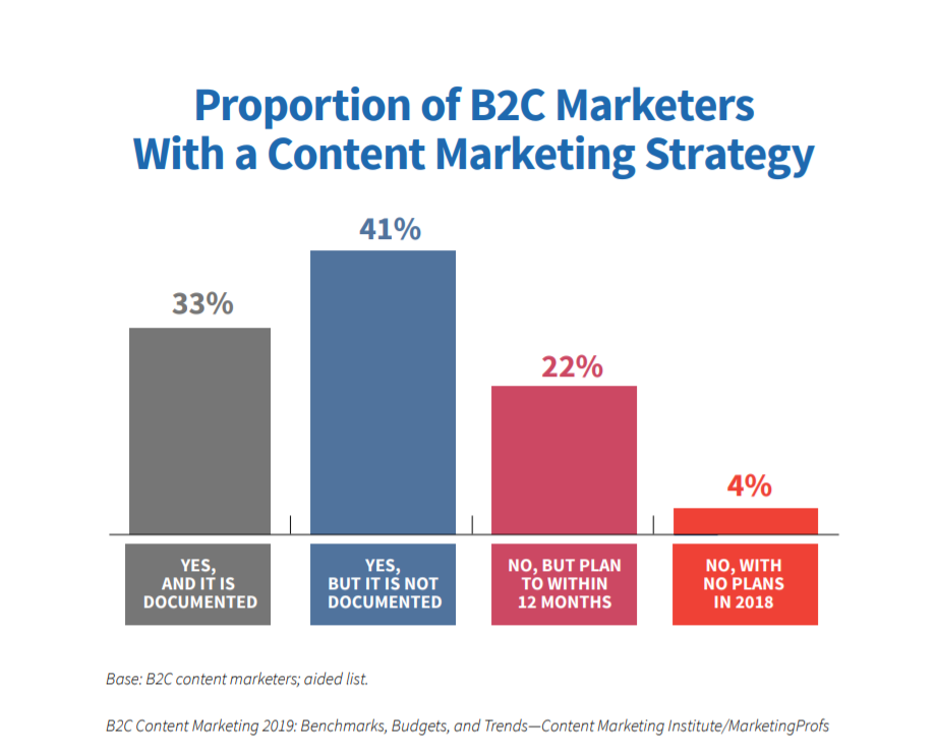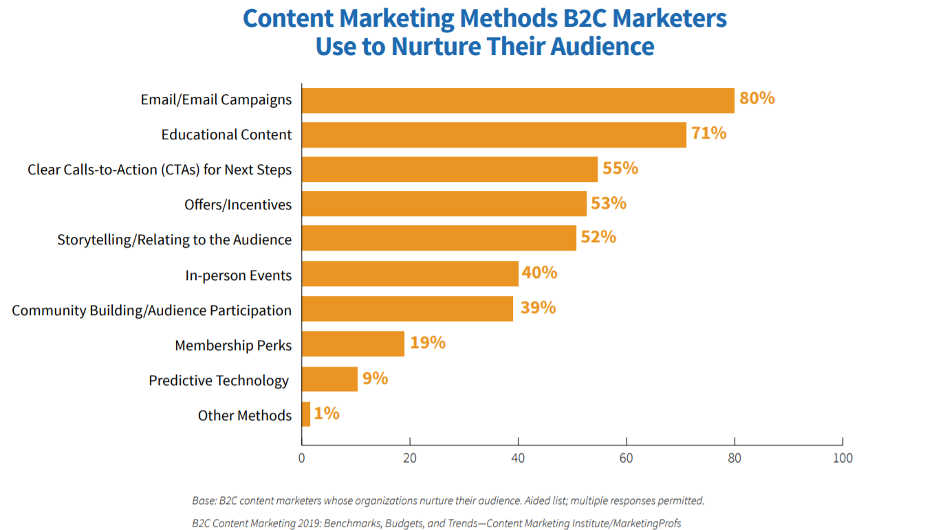And these are not just words tossed in vain. According to the Content Marketing Institute, in 2018, nearly three-quarters of marketers believed that content marketing is crucial to their success. The same trend continues up to today, as 70% of marketers actively invest in content marketing. What is content marketing, though? How do you run a content marketing campaign, and what does it involve? How about budgets? And what types of content perform better? We have put together a guide to help you grasp the true meaning of what is content marketing. Read on and find out more.
What is Content Marketing?
If you are looking for a short answer for what is content marketing, then you should know that, well, content marketing is a branch of marketing focused on creating and distributing content that is valuable and relevant to a business’s target audience.
That is, of course, the short version of what content marketing is. The long version is that content marketing is pretty much most marketing you see happening online. It might sound like we’re a bit biased here, but just hear us out. There are several branches of digital marketing:
SEO Social Media Marketing Email Marketing Public Relations PPC
If you look closely, none of these would actually “work” if it weren’t for content marketing to be the beating heart behind each of them.
Search Engine Optimization is all about bringing content forward, Social Media Marketing is more or less an extension of content marketing as it comes to complement it, Email Marketing relies on content to be engaging and effective, Public Relations deal in what people want to read, rather than what PR specialists want to read, and PPC needs content as its backbone to be efficient (otherwise, it’s just money tossed down the drain, most times).
Content marketing is, as the Content Marketing Institute puts it, the past, present, and future of marketing in general – and not just in the digital world, but everywhere else as well. Beyond anything else, content marketing is educational without focusing on the actual products or services a company sells, but on the adjacent background needed to make the magic of marketing happen. Content marketing aims to educate the reader and inform them about not only the products and services and how they can be used, but about the entire spectrum of adjacent industries, fields of expertise, and topics that could help the reader gain a deeper understanding of the world and use it to their own advantage. Yes, writing about your products and the specific niche you are in is obviously important. But real content marketing happens beyond that, in the tiny cracks of the informational void you fill in the life of your readers, followers, and users. Content marketing:
Drives sales by pushing users down the sales funnel Makes customers more loyal to your brand precisely because your brand is not sales-y Creates a connection with potential advocates of your brand
Or, in other words, content marketing is the mechanism of pumping blood through all the veins of your overall marketing approach.
What is Content Marketing Strategy?
You cannot do proper content marketing without a content marketing strategy – and if anyone tells you otherwise, please turn to 180 degrees and run, because they are more than likely lying through their teeth. The content marketing strategy you use is quintessential to your success, precisely because this strategy will dictate every step of the way – from a simple piece of content to how you make it work for your business. Most content marketers do have some sort of content marketing strategy in place. As studies show, though, the main differentiating factor is related to how well-documented the strategy is.
Every content marketing strategy should rely on three main pillars:
Who is your target audience?
Who are the users that are most likely to buy your product? Where on the internet, do they hang out? What kind of things do they read and consume in terms of content? What are the things they like, and how about the things they don’t like? What type of content are they more likely to love? And, most importantly, what problem will you actually solve for them?
Who is your company?
What kind of products do you sell, and what are the values you believe in as a business? What are your differentiating factors, when compared to your competitors?
What is your goal?
What are you trying to achieve with your content marketing strategy, and what are the specific KPIs you want to follow through over the next quarter or year? What are the results you are expecting from your content marketing efforts?
How to Create a Content Marketing Strategy?
To meet all the above questions and create a solid content marketing strategy, you need to follow these steps:
Research your user personas
Do it using Google Analytics (and other analytics tools you might have at your disposal), do it using surveys, do it using personal interviews. Gather as much information about your prospective customers as possible and lay it down on paper. Then, split everything into groups of typologies. Name each typology and imagine a real-life for them, so that you can get to know them better.
Set your goals
Remember, this has to be a very specific goal you are aiming for, not just random “dreams”. Your goals should be data-specific and clear. Instead of saying, “We want to convert more customers”, say, “We want to convert 100 customers via our content marketing strategy, by the end of July”.
Audit your content
Where are you standing now? What are some of the things that do not match the aforementioned two points (the user personas and the goals)? How about SEO? Are you promoting your content on the right channels, what are numbers saying about it?
Brainstorm your future content
Think of content ideas people might appreciate. Also, think of what types of content and channels are best for your specific situation. Create a clear, concise, and compelling content calendar to use for the next three months at least and actually stick to it. When brainstorming content ideas, keep in mind that you can also make use of tools that might help you find ideas that are more matching with your actual goals and audience. Some of these content marketing tools include:
Buzzsumo News sites your target audience reads Blog Title Generator Surveying your current audience Auditing your competitors’ content Comments on social media and on your blog Your audience’s reaction to your current content on different platforms and channels A thorough SEO and keyword research (e.g., keywords your target audience might be searching for)
Create the content
Keep in mind that quality should reign supreme over quantity and that you should focus on delivering actually useful information to your audience. Otherwise, you might end up in a situation where you keep on hoarding your content without seeing any kind of results (or just nothing that matches up with your expectations, really).
Distribute and promote your content
There are two schools of thought when it comes to promoting content. The first one says that you should distribute and promote your content every way there is (e.g., on every social media channel, via organic and paid posts, on email, on major sites, and so on). The second one is more granular and segmented and says that you should distribute and promote your content only to those channels that have a proven track record of success for your specific business. For instance, if you sell tractors, it is unlikely that your target audience will be hanging out on Instagram a lot – and as such, it would be best for you if you focused on channels where your target audience is more likely to actually stumble upon your content.
Measure
If you’re doing content marketing and not measuring your results, it’s all for nothing. Yes, there might be people coming into your business via your content – but if you don’t actually measure this, you will never know. Some of the best tools to use when measuring the effectiveness of your content marketing include:
Good ol’ Google Analytics Eye and movement tracking tools like CrazyEgg Conversion Optimization tools that allow you to A/B test your content
Some of the KPIs you might want to watch out for when measuring the effectiveness of your content marketing strategy include the following:
Traffic Time spent on page Bounce rate Click-through rate Scroll depth Comments, shares, and overall engagement Links (how many sites publish your content’s link on their pages) Rankings Generated leads that started on the pages containing your content Conversions Customer lifetime value (how many of the customers attracted via content marketing return to your business and the financial value associated with this) Customer acquisition costs (how much you invested in your content and how many customers one piece of content generated) ROI
Do keep in mind that just because you haven’t reached one KPI, it doesn’t mean you should drop the whole content marketing effort. It is essential to spot where exactly things might have gone wrong and make changes accordingly. Shift your strategy to adopt a new one that matches your results and your expectations. Sadly, content marketing strategy is very frequently a game of trial and error – so don’t be afraid to experiment, even if it may sometimes move past the borders of what you know and what you are familiar with. Think out of the box, as one may say!
Types of Content Marketing
Deciding on what type of content you should create is quite important for the success of your strategy. Remember that not all types of content are suitable for everyone and for all types of businesses, so try to only decide on those that will actually attract your target audience and match your goals. The main types of content marketing include:
Blogs and articles Video marketing Podcasts Content marketing via email Infographics Lead magnet content (eBooks, whitepapers, case studies) Quizzes or tools Slideshare presentations Courses and webinars Social media posts Free apps
There is no right or wrong type of content, mind you. There is, however, content that is poorly executed and insufficiently promoted. And there is content that manages to hit the soft spot in the target audience, slowly bringing them closer to your target audience. Furthermore, it is also important to mention that your content marketing strategy will most likely not show fast results. The most optimistic specialists say that content marketing shows results about six to nine months after the release of the actual content (for instance, Neil Patel supports this idea). The less optimistic specialists say that it can take up to a year before your content marketing strategy will start to show actual results. Yes, you need patience, and yes, there’s quite a lot of time and financial investment involved in everything. But yes, it will pay off.
Content Marketing Tips
The basics of content marketing haven’t changed much since its very beginning (which, by the way, have nothing to do with the advent of the digital age, as content marketing via company magazines had started to be a popular tactic ever since the end of the 19th century).
However, content marketing does shift and adapt to the ages – and as such, every year brings along new content marketing tips and techniques you might want to try. Remember, though: just because something is popular, it doesn’t mean you have to try it out even if it doesn’t fit your overall strategy, brand, or target audience. That being said, here are some of the most popular content marketing tips for 2020:
Understand the Audience
You really have to stop considering your target audience as mere numbers in a data sheet. They are people. As such, your content should address the humane side of them. It should make them smile. It should solve problems. It should keep them entertained and informed. It should tap into their emotions. It should actually talk to them as humans.
Multimedia Content
Multimedia content is gaining popularity. Indeed, this might be more of a financial investment, but it can actually pay off. In 2019, no less than 83% of the content marketers agreed that video marketing offers them the best ROI, showing that although the costs of generating and promoting video content are higher, the results are directly proportional as well.
Get Data-driven
There’s no other better way to do marketing, really. Creating content-based on the data you get from various sources (Analytics, your paid campaigns, surveys, the overall reaction to your content on social media and in comments, and so on). Once you get this data, you can narrow it down to bits of content that truly respond to your potential customers’ needs and wants – and that is truly priceless.
Tell Stories
People love a good story, and if it matches your brand, your target audience, and your goals, you’re in for a win. Of course, this is not about telling fairytales, but about matching your content marketing strategy with real stories that drive emotion and action. Probably the best example in recent years? Nike’s “Just Do It” campaign – risky, emotional, and engaging at the same time.
Incorporate User-generated Content
Studies show that a staggering 92% of the people trust user-generated content more than anything else. That’s telling enough about just how powerful your users’ experience and opinions are when it comes to generating new leads and conversions.
Drip Marketing
Match your content with a drip-email campaign. Email automation can help you create email campaigns that actually draw potential customers back into your funnel, even if they have fallen apart. Remember, the most successful email marketing campaigns are engaging, conversational, and natural – so try to aim for that when writing your email copy.
Virtual Reality and Augmented Reality
This might sound Science-Fiction, and it might definitely cost quite a bit, but the results can be amazing. If your target audience is excited by everything tech, VR and AR are the cutting edge content marketing options you should absolutely consider. So, after everything explained here, what is content marketing? As self-centered as it may sound, content marketing is the core of every solid digital marketing approach. It is not a magic wand to fix all your marketing issues, for sure. It’s not a quick fix, nor is it something to be done spontaneously and sporadically. It is a conscious, consistent, and strategized effort to bring people towards your business by informing and entertaining them at the same time. Content marketing is that “something” you cannot really “live” without in 2020, as a marketer. There is no secret recipe for doing successful content marketing. Unfortunately, nobody can build a strategy that is guaranteed to work 100%, no matter how experienced they are. What a good content marketer will do, however, is keep in mind that some ingredients are statistically known to make content marketing more successful. To give you an idea, we will leave you with this document from the Content Marketing Institute’s B2C Content Marketing 2019 Benchmarks, Budgets, and Trends – North America:




